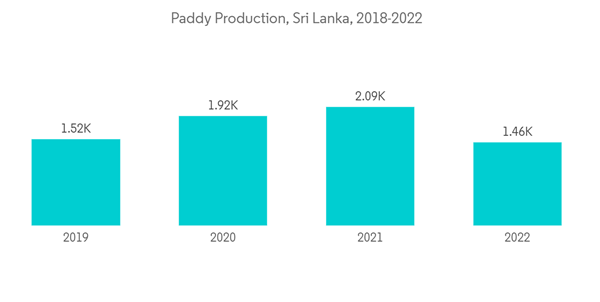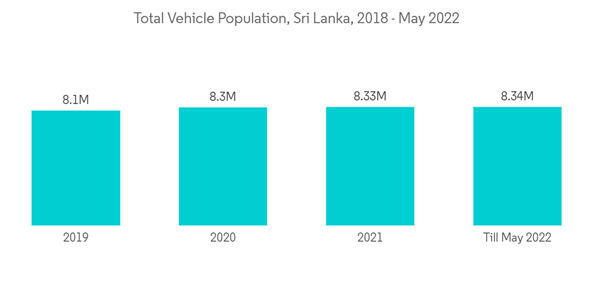Key Highlights
- Due to government-imposed lockdowns and limitations, the market in the country has witnessed a dramatic decline during the COVID-19 epidemic. The automobile sector had a slump in 2021 as a result of a car import restriction and the closure of some factories owing to environmental concerns. The market is expected to see an upward trend in the forecasted years.
- Increasing usage of lubricants in automobiles and increasing demand from the agricultural machinery sector are driving market growth. Reduced mining and building activity are projected to stifle market growth. The development of bio-based lubricants is expected to act as an opportunity for the market studied.
Srilanka Lubricant Market Trends
Growing Demand for Heavy Equipment from Agriculture Segment
- Sri Lanka, a small nation, has been an agricultural country for a very long time. The agriculture sector in the country accounts for around 7% of the national GDP, with the fisheries sector accounting for 1.2 percent and the livestock industry accounting for 0.6 percent.
- Tractors, cultivators, plows, harrows, seed drills, transplanters, and other types of agricultural equipment are commonly employed in agriculture. Lubricants such as Engine oils, Hydraulic fluids, Gear oils, Transmission oils, Greases, and other such lubricants are used in various applications in the Agricultural industry to protect them from wear and tear caused due to continuous usage.
- The government of Sri Lanka has issued many policies in order to improve the agricultural sector in the country. As per data published by the Department of Census and Statistics, Government of Sri Lanka, paddy production reached 1462 thousand metric tonnes in 2022.
- With modern agriculture machinery and technology nowadays, farming has improved more like a science than an art. Using technology and machines in agriculture is only for the goal of increasing production and efficiency and making farming more sustainable. The use of such advanced machinery in agriculture is likely to boost the country's lubricant consumption.
Engine Oils to Dominate the Product Type Segment
- Engine oil is a key lubricant that plays a vital role in the combustion cycle. It is composed of two elements, including base stock and additives. Engine oils are primarily used for the lubrication of engine parts that are constantly in friction.
- Engine oils find applications in various end-user industries, including automotive, power generation, heavy-duty equipment, and other industries. Engine oils reduce the tension between the contact of parts and enhance heat transfer by forming a thin layer between the moving components.
- There are three types of engine oils mineral engine oils, fully synthetic engine oils, and semi-synthetic engine oils. Some of the key roles of engine oil are Lubrication - Engine oil is used to reduce wear and tear of engine parts. Cooling - It acts as a coolant for certain engine parts heated by the combustion and friction between mechanical parts.
- Dissipating heat from engine parts leads to an increase in their overall lifespan and efficiency; Cleaning - Engine oils carry impurities, such as dust and combustion residues, from the engine to the oil filter and prevent engine parts from clogging, Protection against corrosion - In engine parts, the combustion of fuel leads to the formation of corrosive acid, further deteriorating metallic engine parts. Additives such as corrosion inhibitors are added to engine oils to get rid of this corrosion. However, over time, engine oil may oxidize due to direct contact with oxygen, reducing its corrosion-inhibiting capabilities. Therefore, engine oil needs to be changed on a regular basis, and Sealing - Engine oil increases engine sealing, specifically the sealing of pistons and cylinders, by forming protective layers between engine parts and filling respective clearances.
- According to the Department of Motor Traffic of Srilanka, the total vehicle population in the country in May 2022 was 8,341,861 vehicles, which increased from 8,331,702 vehicles at the end of 2021. Around 10,159 vehicles were registered in the country in the first five months of 2022. The increase in vehicle population is expected to boost the demand for lubricants in the country.
- Owing to such suitable functionalities, engine oils are used in passenger vehicles, heavy-duty machinery, and other end-use applications. Therefore, with the growth in the production and sale of vehicles and machinery and growing industrial investments, engine oil consumption will likely increase in Sri Lanka in the coming years.
Srilanka Lubricant Industry Overview
The Sri Lanka lubricants market is consolidated in nature, with a few major players occupying a large portion of the market. Some of the major companies (not in any particular order) are Chevron Ceylon Limited, Indian Oil Corporation Limited, Laugfs Holdings Limited, ExxonMobil Asia Pacific Pte., and Bharat Petroleum Corporation Limited, among others.Additional Benefits:
- The market estimate (ME) sheet in Excel format
- 3 months of analyst support
This product will be delivered within 2 business days.
Table of Contents
Companies Mentioned (Partial List)
A selection of companies mentioned in this report includes, but is not limited to:
- Bharat Petroleum
- BP Middle East LLC
- Ceylon Petroleum Corporation
- Chevron Lubricants Lanka PLC
- ExxonMobil Asia Pacic Pte
- Indian Oil Corporation Limited
- Laugfs Holdings Limited
- Lubricant Company Sinopec
- Motul
- Shell Markets (Middle East) Limited
- Total Oil India Private Limited
- Toyota Tsusho Corporation
- Valvoline LLC










